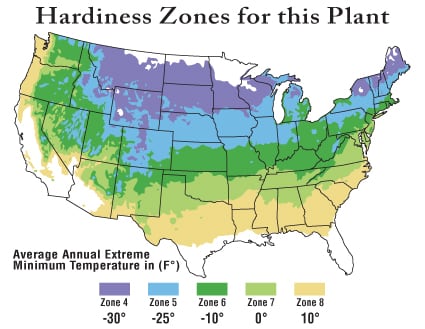Fuji Apple
Plant Type: Dormant, bare-root
Zones: 4-8
Soil Type: Clay, Loamy & Sandy Soils
Site Selection: Full Sun
Mature Height & Width: 15-20' Height and 15-20' Spread
Growth Rate: Moderate - 12-24" per year once established
Moisture Requirements: Average






Fuji Apple Tree
The Fuji apple is a small to medium size apple with a reddish pink over yellow appearance. Great tasting, the Fuji apple features a crisp flesh and a delicious mild flavor with very little tartness. The Fuji is great for eating fresh, making cider or using in salads since it does not brown easily. The apples from a Fuji will store well for 3 to 6 months after harvest as long as they are kept refrigerated. A large crop of apples is common with this selection, but it does need to be pollinated with another variety. All of our apple trees will pollinate one another. Apple trees prefer deep, fertile, moist but well drained soil but will grow in clay and sandy soil as well.
Click on the "More Info" tab below for proper planting and care information.
*This Apple tree is a standard size and should reach a height and spread of 20-25' at maturity. A whip is simply a younger tree with little or no side branching.
Planting Instructions for Apple Trees
Site selection
First off, make sure you pick a correct planting location. Apple trees should receive at least 6 hours of full sun during the day. When possible, it is beneficial to have morning sunlight shine on your apple trees. This will help dry the dew which has formed on the leaves overnight and greatly lower the chance of diseases such as powdery mildew.
Soil considerations
Apple trees prefer deep soil that is not compacted and is well drained. If you are planting one in an area of heavy clay, a spot which was compacted by heavy equipment such as a bulldozer, or an area which is routinely wet, seriously consider making a raised planting bed. The bed should be 1.5’ to 2’ deep and six to eight feet wide. Fill the bed with rich topsoil, a sandy loam mixture is ideal when available. A bed such as this will let the roots penetrate the soil and allow proper drainage to occur.
Planting method and root depth
Soak the apple tree in a bucket or tub of water for 3-4 hours prior to planting. This will allow the tree to properly hydrate before it is placed into the ground. Next, dig your planting hole large enough that all of the roots are naturally spread out. The ideal position of the roots when the tree is planted is the same position they are in before planting. The roots of the tree should not be bent up or down or curl around inside of the planting hole. The planting depth is important too. Use a bamboo stake or other thin, rigid object and lay it across the planting hole. Look for the soil line on the tree from when it was removed from its original planting location and plant the tree at the same depth. If no soil line is visible, plant the tree so the graft union is visible at the soil line. The graft union should not be out of the ground and it should not be buried. Fill the planting hole with soil and firm the soil around the root system. Be sure that the soil is firm enough that it will not settle when watered and that the roots are not too compacted. Soak the planting site well and recheck the planting depth one last time.
Watering
Making sure your new apple trees receive the proper amount of moisture is critical to their survival. It is important that the trees get a deep watering at least once per week from either a rain event or a supplemental watering that you do yourself. Trees receiving too much regular watering can be killed. A thorough soaking and then letting them sit for the next week is ideal rather than watering each day. This also forces the roots down into the soil rather than staying shallow. We recommend placing a layer of mulch which is 2-3’ wide and 3-5” deep around your newly planted tree. This will help the soil retain moisture and help moderate the temperature around the root zone. Just be sure that the mulch does not touch the trunk of the tree. Mulch up against the trunk of a tree can cause moisture to build up, and create an ideal place for insects and pests, diseases and decay.
Protecting your trees
Finally, it is important to protect your trees from the pests of the furry variety. Rabbits and deer are the worst offenders and can make short work of fruit trees, especially younger ones. If rabbits or deer are a problem in your area, place a fence that is 48” high and 3-4’ in diameter around your trees. This last step will save you the headaches of coming to find damage or destruction of your own orchard.




